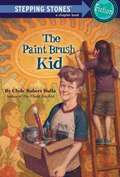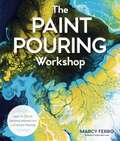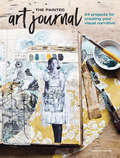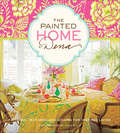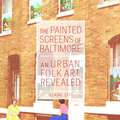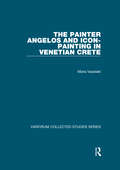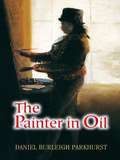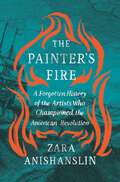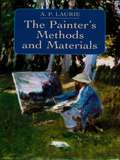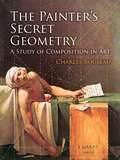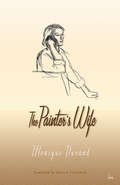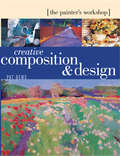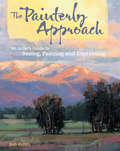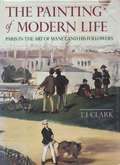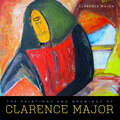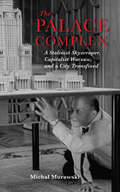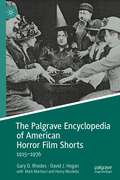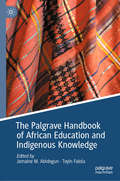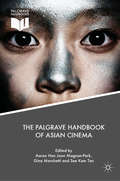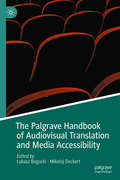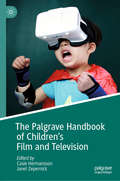- Table View
- List View
The Paint Brush Kid (Stepping Stone Book)
by Clyde Robert Bulla Ellen BeierUncle Pancho is about to lose his house! Gregory and his friends love Uncle Pancho. He isn't really anyone's unclehe's their friend. When he begins to tell the story of his life, Gregory has an idea. He will paint the story of Uncle Pancho's Life . . . and maybe, just maybe, the painting will help save Uncle Pancho's house.
The Paint Pouring Workshop: Learn to Create Dazzling Abstract Art with Acrylic Pouring
by Marcy FerroJump into the exciting world of paint pouring—and instantly create dazzling, abstract art—with this comprehensive how-to guide by the popular founder of the Mixed Media Girl YouTube channel. Paint pouring—which involves using a free-flowing acrylic paint mixture created with a pouring medium, such as glue and water—is the hottest trend for making abstract art. In this fun, colorful guide, Marcy Ferro explains everything about working in this popular form. Learn how to create eye-catching color combos, set up a dedicated (or a paint-proof) workspace, control your pours, and much more. Along with the essentials, Ferro demonstrates a wide range of techniques, from familiar favorites such as the dirty pour and flip cup to novel ways of manipulating paint with a hair dryer or string. With Marcy&’s guidance, mesmerizing paintings are just a pour away!
The Painted Art Journal: 24 Projects for Creating Your Visual Narrative
by Jeanne OliverTake a mixed-media journey to the very heart of your creativity!The Painted Art Journal opens doors to your most personal and authentic art yet. Tell your story as only you can, through a series of guided projects that culminate in a beautiful, autobiographical art journal worthy of passing along to future generations. Along the way, you will hone your own unique style of artful storytelling, filled with the images, colors and symbols that resonate most powerfully with you. Twenty-four inventive, step-by-step prompts help you to:Set the scene for making art--from establishing rituals that unlock creativity to curating a personal storyboard.Draw inspiration from photos, typography, sketches, childhood memories, quotes and more.Shape your story with timelines, gathered-word poetry and simple approaches to portraits.Express yourself through an exciting range of mixed-media techniques, using everything from pen and ink, markers and watercolor to image transfers, printmaking with linocuts, acrylic and collage.A book unlike any other, The Painted Art Journal is all about digging deeper, honoring your life, and coming away with a truer understanding of yourself and your art. "Each of our stories is so different, lovely and broken in its own way." --Jeanne Oliver
The Painted Home by Dena: Patterns, Textures, and Colors for Inspired Living
by Dena FishbeinA renowned designer shares surprising ways to add color, texture, and creativity to your home. In this beautifully illustrated book, the woman behind internationally acclaimed merchandise company Dena Designs shows how her hand-painted style combines vintage and traditional elements with a modern twist. Pick up a paintbrush and take a walk through the author&’s own home, room by room, as she discusses her inspirations and demonstrates her methods for encouraging creativity. The Painted Homeby Dena features simple DIY projects, useful design tips, and personal stories from one of the most successful entrepreneurs in the textile and design business.
The Painted Screens of Baltimore: An Urban Folk Art Revealed (Folklore Studies in a Multicultural World Series)
by Elaine EffPainted screens have long been synonymous in the popular imagination with the Baltimore row house. Picturesque, practical, and quirky, window and door screens adorned with scenic views simultaneously offer privacy and ventilation in crowded neighborhoods. As an urban folk art, painted screens flourished in Baltimore, though they did not originate there--precursors date to early eighteenth-century London. They were a fixture on fine homes and businesses in Europe and America throughout the Victorian era. But as the handmade screen yielded to industrial production, the whimsical artifact of the elite classes was suddenly transformed into an item for mass consumption. Historic examples are now a rarity, but in Baltimore the folk art is still very much alive.The Painted Screens of Baltimore takes a first look at this beloved icon of one major American city through the words and images of dozens of self-taught artists who trace their creations to the capable and unlikely brush of one Bohemian immigrant, William Oktavec. In 1913, this corner grocer began a family dynasty inspired generations of artists who continue his craft to this day. The book examines the roots of painted wire cloth, the ethnic communities where painted screens have been at home for a century, and the future of this art form.
The Painter Angelos and Icon-Painting in Venetian Crete (Variorum Collected Studies)
by Maria VassilakiThe sixteen studies in this book include six specially translated from Greek and another two published here for the first time. They deal with the art of painting in Crete at a time when the island was under Venetian rule. The main emphasis is on the 15th century and especially on the painter Angelos. More than thirty icons with his signature survive, and at least twenty more can be reliably attributed to him. Angelos was the most significant artist of a particularly significant era. It was at this time that the centre of artistic production migrated from Constantinople, the capital of the Byzantine Empire to Candia, the capital of Venetian-occupied Crete. These studies try to reconstruct the personality of this late Byzantine painter, Angelos, not only through his icons but also through his will (1436), now in the State Archives in Venice. In this context they also explore the status of the Cretan painter in society. The large number of extant Cretan icons clearly indicates the striking increase in production from the 15th century onwards. Similarly, archival documents are used to examine the trade of icons in Crete and the way Cretan artists had to organize their workshops in order to meet the requirements of the market.
The Painter and the President: Gilbert Stuart's Brush with George Washington
by Sarah AlbeeGeorge Washington hated having his portrait painted, but as president of the United States, he knew his image needed to live on. This nonfiction picture book explores how artist Gilbert Stuart created Washington&’s most lasting and recognized portrait—the one that&’s used on the one-dollar bill.George Washington and artist Gilbert Stuart didn&’t always see eye-to-eye, but both men knew the importance of legacy and the power of art. Though George disliked having his portrait painted—which took days and days to complete—he knew his place in history would require people to know his face. Fortunately, Gilbert Stuart&’s unique way of painting didn&’t compel his subjects to sit for hours on end—in fact, he encouraged them to move around and even bring friends to chat with. Capturing the soul of each subject, his portraits were unlike any other artists&’. And Gilbert Stuart&’s one-of-a-kind portrait of Washington stands the test of time—it&’s the one that&’s used on the one-dollar bill.
The Painter and the Wild Swans
by Claude ClémentTransfixed by the beauty of a passing flock of white swans, a Japanese painter finds that he cannot work until he sees them again.
The Painter in Oil
by Daniel Burleigh ParkhurstA widely cited resource on painting in the style of the old masters, this classic guide contains a wealth of insights for amateur and professional artists. Daniel Burleigh Parkhurst, one of the foremost artist/instructors of the early 20th century, presents a master's course in the science and technique of painting that encourages the use of traditional tools and methods.Parkhurst's four-part treatment encompasses materials, general principles, technical principles, and practical applications. Topics include canvases, easels, brushes, paints, and other tools; attitude and originality; drawing, perspective, light and shade, composition, and color; and sketching, still life, flowers, portraits, landscapes, and figures. 64 illustrations enhance this informative manual.
The Painter's Eye
by Maurice GrosserA painter discusses the conventions and revolts, the psychology, techniques, and problems of painting from the Renaissance to the present day. An invaluable aid in the appreciation and understanding of art.
The Painter's Fire: A Forgotten History of the Artists Who Championed the American Revolution
by Zara AnishanslinTold through the lives of three remarkable artists devoted to the pursuit of liberty, an illuminating new history of the ideals that fired the American Revolution.The war that we now call the American Revolution was not only fought in the colonies with muskets and bayonets. On both sides of the Atlantic, artists armed with paint, canvas, and wax played an integral role in forging revolutionary ideals. Zara Anishanslin charts the intertwined lives of three such figures who dared to defy the British monarchy: Robert Edge Pine, Prince Demah, and Patience Wright. From London to Boston, from Jamaica to Paris, from Bath to Philadelphia, these largely forgotten patriots boldly risked their reputations and their lives to declare independence.Mostly excluded from formal political or military power, these artists and their circles fired salvos against the king on the walls of the Royal Academy as well as on the battlefields of North America. They used their talents to inspire rebellion, define American patriotism, and fashion a new political culture, often alongside more familiar revolutionary figures such as Benjamin Franklin and Phillis Wheatley. Pine, an award-winning British artist rumored to be of African descent, infused massive history paintings with politics and eventually emigrated to the young United States. Demah, the first identifiable enslaved portrait painter in America, was Pine’s pupil in London before self-emancipating and enlisting to fight for the Patriot cause. And Wright, a Long Island–born wax sculptor who became a sensation in London, loudly advocated for revolution while acting as an informal patriot spy.Illuminating a transatlantic and cosmopolitan world of revolutionary fervor, The Painter’s Fire reveals an extraordinary cohort whose experiences testify to both the promise and the limits of liberty in the founding era.
The Painter's Methods and Materials (Dover Art Instruction)
by A. P. LaurieMany of the valuable techniques and materials formerly used in painting have been lost or forgotten. With the convenience of the art supply store, the artist is no longer forced to acquaint himself with many of the operations performed by the great craftsmen-painters of the past. The result is that the modern painter often does not understand the chemical and physical reasons for the steps he follows. This book bridges the gap between artist and craftsman, and gives the reader insights into the classical techniques of the great masters as well as the procedures followed today.Professor Laurie has based his book on an intensive study of great master paintings and manuscripts as well as on actual experiment. He covers techniques for painting on wood panels, paper, walls, and canvas, and for dealing with watercolors, tempera, fresco, pigments and colors, balsams, resins, turpentines, varnishes, waxes, sizings, and various oils such as walnuts, linseed, and poppy. The reader will also find much information on the behavior of light through various refractions, prism effect in layers of paint, and the cleaning and preservation of pictures.The discussion is illustrated by 48 full-page plates. These reproductions of actual paintings by major and minor masters -- Rembrandt, Lippi, Michelangelo, Botticelli, Rubens, Hals, and others -- were selected to show specific points of painting condition or technical procedures. Microphotographs are used to show cross-sections of painting, age cracks, flaking, pigment particles, and similar material.
The Painter's Secret Geometry: A Study of Composition in Art
by Charles Bouleau"This is an outstanding text for teachers and students." — The Studio This richly illustrated examination of visual arts in the European tradition shows how the great masters employed the "golden mean" and other geometrical patterns to compose their paintings. Author Charles Bouleau explores a tremendous variety of ancient and modern works: the Parthenon friezes, Italian mosaics, the Bayeux Tapestry, and Gothic stonemasons' marks of France and Germany as well as paintings by Picasso, Kandinsky, Klee, and Pollock. His insightful expositions cast new light on such well-known works as Raphael's "The School of Athens," Botticelli's "Birth of Venus," Rubens' "Descent from the Cross," and Renoir's "Le Moulin de la Galette." Advancing step by step through each painter's vast body of work, the survey highlights new contributions from each period and artist. Every analysis is conducted according to strict methods, placing the work within the intellectual atmosphere of its time. Original, informative, and stimulating, The Painter's Secret Geometry reveals the framework of art as well as its most profound and secret poetry. This new edition of the cult classic is a vade mecum for any student of art history or artistic composition. "I found the material presented in this book to be fascinating. Though originally published in the 1960's it's tenets hold up well. It would lend itself well to an art history course or to anyone interested in the concepts outlines." — Tacoma Public Library
The Painter's Wife
by Sheila Fischman Monique DurandInspired by the lives of two great artists - Evelyn Rowat, fashion illustrator, and René Marcil, painter - The Painter's Wife, a novel about art and passion, is written in a language as brilliant and intense as the mercurial lives of its completely contradictory characters.
The Painter's Workshop - Creative Composition & Design: Creative Composition And Design (The\painter's Workshop Ser.)
by Pat DewsStart every painting the right way - with a composition and design that works!Good composition and design is the underlying foundation of any successful painting. Let Pat Dews show you what good design really is while detailing the principles that can improve your work with every stroke.You can learn how successful painters use the fundamentals of composition in unique ways to create gorgeous works of art in a variety of media, including watercolor, pastel, collage and more:Let light and shadow lead your compositionTell a story with the elements of designConstruct a composition with colorAllow a composition to evolve as you paintMove from literal interpretation to ImpressionismUse your computer as a tool for creative designSome use different techniques to decide what will work before committing to a final composition; others design their paintings before even picking up a brush. A few combine the two approaches. Dews helps you discover the method that's best for you!She also illustrates how to bring every painting to a great finish through an invaluable critique of student work. It's all the information you need to start composing beautiful art the moment your brush hits the paper.
The Painterly Approach: An Artist's Guide To Seeing, Painting And Expressing
by Bob RohmCreate paintings with feelingThe Painterly Approach bridges the gap between what you see as an artist, and what you feel. More than painting an appealing landscape, it's about making your viewer feel the wind, experience the dance of shadows and sunlight, and admire the wondrous intermingling of colors that attracted you to your subject in the first place.In this gorgeously illustrated book, Bob Rohm shows you how to see the world from a painterly perspective and translate it into expressive, poetic paintings that elicit an emotional response from your viewer.Clearly illustrates how to choreograph color, value, composition, texture and other fundamental elements to achieve those elusive qualities of mood and emotionFeatures 9 step-by-step demonstrations (in oil, pastel and acrylic) on capturing a vivid sense of time and placeCovers brushstrokes, painting with a palette knife, edge control, shadows and other advanced art techniquesThis book focuses primarily on landscape painting but offers valuable lessons for approaching any subject in a personal and engaging way.
The Painting of Modern Life: Paris in the Art of Manet and His Followers
by T. J. ClarkFrom T.J. Clark comes this provocative study of the origins of modern art in the painting of Parisian life by Edouard Manet and his followers. The Paris of the 1860s and 1870s was a brand-new city, recently adorned with boulevards, cafés, parks, Great Exhibitions, and suburban pleasure grounds—the birthplace of the habits of commerce and leisure that we ourselves know as "modern life." A new kind of culture quickly developed in this remade metropolis, sights and spectacles avidly appropriated by a new kind of "consumer": clerks and shopgirls, neither working class nor bourgeois, inventing their own social position in a system profoundly altered by their very existence. Emancipated and rootless, these men and women flocked to the bars and nightclubs of Paris, went boating on the Seine at Argenteuil, strolled the island of La Grande-Jatte—enacting a charade of community that was to be captured and scrutinized by Manet, Degas, and Seurat. It is Clark's cogently argued (and profusely illustrated) thesis that modern art emerged from these painters' attempts to represent this new city and its inhabitants. Concentrating on three of Manet's greatest works and Seurat's masterpiece, Clark traces the appearance and development of the artists' favorite themes and subjects, and the technical innovations that they employed to depict a way of life which, under its liberated, pleasure-seeking surface, was often awkward and anxious. Through their paintings, Manet and the Impressionists ask us, and force us to ask ourselves: Is the freedom offered by modernity a myth? Is modern life heroic or monotonous, glittering or tawdry, spectacular or dull? The Painting of Modern Life illuminates for us the ways, both forceful and subtle, in which Manet and his followers raised these questions and doubts, which are as valid for our time as for the age they portrayed.
The Paintings and Drawings of Clarence Major
by Clarence MajorIn the first volume to collect the paintings and drawings of Clarence Major, readers are offered six decades of unique, colorful, and compelling canvases and works on paper—works of singular beauty and social relevance. These works represent Major’s personal painterly journey of passionate commitment to art.This generous selection of more than 150 paintings and drawings shows us the melding of rich ideas and fertile images, the braiding of imagination and motif. With their pleasing arrangement of elements, the works come vividly to life. Major often juxtaposes a decorative scheme with his own unique choice of color combinations, reinforced with rigorous brushstrokes that release chromatic energy. The paintings complement and challenge the great traditions of Realism, Impressionism, and Expressionism.Major is primarily a figurative and landscape painter. Here we find landscapes of singular vitality, rich in color and design, dramatic landscapes, and cityscapes representing, among other things, Major’s extensive travels in America and Europe. We are also treated to Major’s signature figurative work. In these paintings, he ventures fearlessly into familiar yet unexpected areas of richness.Also included is an introductory essay, “The Education of a Painter,” written by the artist, which further sheds light on and helps to lay a biographical, social, and historical foundation for this essential volume, reflecting a lifetime of serious commitment to painting at its best.
The Palace Complex: A Stalinist Skyscraper, Capitalist Warsaw, and a City Transfixed (New Anthropologies of Europe)
by Michal MurawskiAn exploration of the history and significance of the Palace of Culture and Science in Warsaw, Poland.The Palace of Culture and Science is a massive Stalinist skyscraper that was “gifted” to Warsaw by the Soviet Union in 1955. Framing the Palace’s visual, symbolic, and functional prominence in the everyday life of the Polish capital as a sort of obsession, locals joke that their city suffers from a “Palace of Culture complex.” Despite attempts to privatize it, the Palace remains municipally owned, and continues to play host to a variety of public institutions and services. The Parade Square, which surrounds the building, has resisted attempts to convert it into a money-making commercial center. Author Michal Murawski traces the skyscraper’s powerful impact on twenty-first century Warsaw; on its architectural and urban landscape; on its political, ideological, and cultural lives; and on the bodies and minds of its inhabitants. The Palace Complex explores the many factors that allow Warsaw’s Palace to endure as a still-socialist building in a post-socialist city.“The most brilliant book on a building in many years, making a case for Warsaw’s once-loathed Palace of Culture and Science as the most enduring and successful legacy of Polish state socialism.” —Owen Hatherley, The New Statesman’s“Books of the Year” list (UK)“An ambitious anthropological biography of Poland’s tallest and most infamous building, the Palace of Culture and Science in Warsaw. . . . It is a truly fascinating story that challenges a tenacious stereotype, and Murawski tells it brilliantly, judiciously layering literatures from multiple disciplines, his own ethnographic work, and personal anecdotes.” —Patryk Babiracki, H-Net History
The Palgrave Encyclopedia of American Horror Film Shorts: 1915–1976
by Gary D. Rhodes David J. HoganThe Palgrave Encyclopedia of American Horror Film Shorts chronicles for the first time over 1,500 horror and horror-related short subjects theatrically released between 1915, at the dawn of the feature film era when shorts became a differentiated category of cinema, and 1976, when the last of the horror-related shorts were distributed to movie theaters. Individual entries feature plot synopses, cast and crew information, and – where possible – production histories and original critical reviews. A small number of the short subjects catalogued herein are famous; such as those featuring the likes of Buster Keaton, Laurel and Hardy, The Three Stooges, Bugs Bunny, and Daffy Duck; but the bulk are forgotten. The diverse content of these shorts includes ghosts, devils, witches, vampires, skeletons, mad scientists, monsters, hypnotists, gorillas, dinosaurs, and so much more, including relevant nonfiction newsreels. Their rediscovery notably rewrites many chapters of the history of horror cinema, from increasing our understanding of the sheer number horror films that were produced and viewed by audiences to shedding light on particular subgenres and specific narrative and historical trends.
The Palgrave Handbook of African Education and Indigenous Knowledge
by Toyin Falola Jamaine M. AbidogunThis handbook explores the evolution of African education in historical perspectives as well as the development within its three systems–Indigenous, Islamic, and Western education models—and how African societies have maintained and changed their approaches to education within and across these systems. African education continues to find itself at once preserving its knowledge, while integrating Islamic and Western aspects in order to compete within this global reality. Contributors take up issues and themes of the positioning, resistance, accommodation, and transformations of indigenous education in relationship to the introduction of Islamic and later Western education. Issues and themes raised acknowledge the contemporary development and positioning of indigenous education within African societies and provide understanding of how indigenous education works within individual societies and national frameworks as an essential part of African contemporary society.
The Palgrave Handbook of Asian Cinema
by Gina Marchetti Aaron Han Magnan-Park See Kam TanThis collection offers new approaches to theorizing Asian film in relation to the history, culture, geopolitics and economics of the continent. Bringing together original essays written by established and emerging scholars, this anthology transcends the limitations of national borders to do justice to the diverse ways in which the cinema shapes Asia geographically and imaginatively in the world today. From the revival of the Silk Road as the “belt and road” of a rising China to historical ruminations on the legacy of colonialism across the continent, the authors argue that the category of “Asian cinema” from Turkey to the edges of the Pacific continues to play a vital role in cutting-edge film research. This handbook will serve as an essential guide for committed scholars, students, and all those interested in the past, present, and possible future of Asian cinema in the 21st century.
The Palgrave Handbook of Audiovisual Translation and Media Accessibility (Palgrave Studies in Translating and Interpreting)
by Łukasz Bogucki Mikołaj DeckertThis handbook is a comprehensive and up-to-date resource covering the booming field of Audiovisual Translation (AVT) and Media Accessibility (MA). Bringing together an international team of renowned scholars in the field of translation studies, the handbook surveys the state of the discipline, consolidates existing knowledge, explores avenues for future research and development, and also examines methodological and ethical concerns. This handbook will be a valuable resource for advanced undergraduate and postgraduate students, early-stage researchers but also experienced scholars working in translation studies, communication studies, media studies, linguistics, cultural studies and foreign language education.
The Palgrave Handbook of Bottom-Up Urbanism
by Mahyar Arefi Conrad KickertWho shapes our cities? In an age of increasing urban pluralism, globalization and immigration, decreasing public budgets, and an ongoing crisis of authority among designers and planners, the urban environment is shaped by a number of non-traditional stakeholders. The book surveys the kaleidoscope of views on the agency of urbanism, providing an overview of the various scholarly debates and territories that pertain to bottom-up efforts such as everyday urbanism, DIY urbanism, guerilla urbanism, tactical urbanism, and lean urbanism. Uniquely, this books seeks connections between the various movements by curating a range of views on the past, present, and future of bottom-up urbanism. The contributors also connect the recent trend of bottom-up efforts in the West with urban informality in the Global South, drawing parallels and finding contrast between social and institutional structures across the globe. The book appeals to urbanists in the widest sense of the word: those who shape, study, and improve our urban spaces.
The Palgrave Handbook of Children's Film and Television
by Casie Hermansson Janet ZepernickThis volume explores film and television for children and youth. While children’s film and television vary in form and content from country to country, their youth audience, ranging from infants to “screenagers”, is the defining feature of the genre and is written into the DNA of the medium itself. This collection offers a contemporary analysis of film and television designed for this important audience, with particular attention to new directions evident in the late twentieth and early twenty-first centuries. With examples drawn from Iran, China, Korea, India, Israel, Eastern Europe, the Philippines, and France, as well as from the United States and the United Kingdom, contributors address a variety of issues ranging from content to production, distribution, marketing, and the use of film, both as object and medium, in education. Through a diverse consideration of media for young infants up to young adults, this volume reveals the newest trends in children’s film and television and its role as both a source of entertainment and pedagogy.
